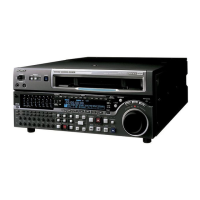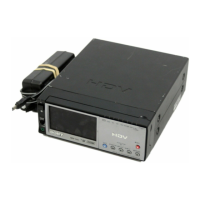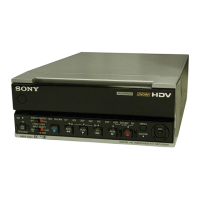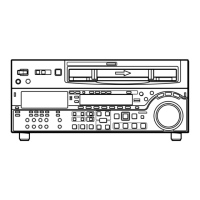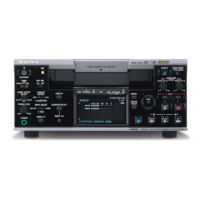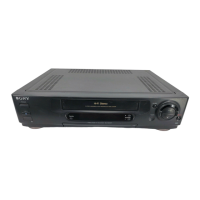Do you have a question about the Sony MSW-A2000 and is the answer not in the manual?
Overview of the unit's design, MPEG IMX format, and playback capabilities.
Illustrates basic and network system configurations connecting various devices.
Provides licensing details for personal and non-commercial use of MPEG-4 Video.
Identifies the three main control panels: Upper, Lower, and Switch.
Lists various input/output connectors for audio, video, time code, network, and external devices.
Illustrates connections for digital, analog, SDTI-CP, and Ethernet devices.
Describes selection of reference signals for video output and servo systems synchronization.
Covers principal setup operations using basic and extended setup menus.
Details information displayed when CHARA function is ON, including time code and messages.
Lists MPEG IMX and other compatible cassette types for recording and playback.
Covers storing and sharing file data among VTRs using a memory stick.
Describes video and audio recording on the unit.
Describes the process of playback of video and audio.
Describes file transmission using the control panel of specific models.
Explains how to perform automatic editing with this unit and another VTR.
Explains achieving variable speed editing by controlling player playback speed.
Lists Quick, Continuous, Standalone, Manual, and Preread editing methods.
Explains recording or using shot marks in MPEG IMX or Betacam SX format for cueing.
Details the four items (G01-G04) in the shot mark operation menu and their settings.
Covers reading, writing, list operations, cueing, data reading, and sorting of shot marks.
Explains Tele-File as a non-contact data carrier system for data management.
Details opening the Tele-File menu from the function menu or automatically.
Covers clip data display, preroll/cue up, modifying data, undo/resume, and attribute data operations.
Explains UMID as a standardized meta-data type for video and audio materials.
Covers recording UMIDs with video signals, selecting type, inheritance, and generation methods.
Describes how to output UMIDs on SDI signals and display UMID data.
Explains essence marks as dictionary items for transferring points like recording start points.
Covers recording essence marks to tape and outputting them via SDI signals.
Explains AED's function in detecting video changes like cuts and flashes.
Covers converting detected events to essence marks and recording cut event time codes to Tele-File.
Explains the function menu for making frequent settings like input signals and time codes.
Lists items for HOME page, Page 1, Page 2, Page 3, Page 4, and Page 5.
Describes the basic and extended setup menus and their item groups.
Covers displaying setup menus, customizing the display, and selecting menu items.
Details items 001-009 related to preroll, character position, synchronize, display, local function, timer, monitoring, and character type.
Lists items 101-106 related to search dial, maximum speed, audio output, audio muting, reference alarm, and capstan lock.
Explains using the setup utility menu for memory stick operations.
Details downloading, uploading, and formatting files saved on memory sticks.
Describes handling tape slack, recommending professional service.
Details using the special cleaning cassette to clean video and audio heads.
Describes how error messages and codes are displayed on the time data and monitor.
Describes moisture condensation on the head-drum and the unit's detecting function.
Details the hours meter's display modes and maintenance timings for scheduled checks.
Covers general, tape transport, video, audio, network, and connector specifications.
Overview of the unit's design, MPEG IMX format, and playback capabilities.
Illustrates basic and network system configurations connecting various devices.
Provides licensing details for personal and non-commercial use of MPEG-4 Video.
Identifies the three main control panels: Upper, Lower, and Switch.
Lists various input/output connectors for audio, video, time code, network, and external devices.
Illustrates connections for digital, analog, SDTI-CP, and Ethernet devices.
Describes selection of reference signals for video output and servo systems synchronization.
Covers principal setup operations using basic and extended setup menus.
Details information displayed when CHARA function is ON, including time code and messages.
Lists MPEG IMX and other compatible cassette types for recording and playback.
Covers storing and sharing file data among VTRs using a memory stick.
Describes video and audio recording on the unit.
Describes the process of playback of video and audio.
Describes file transmission using the control panel of specific models.
Explains how to perform automatic editing with this unit and another VTR.
Explains achieving variable speed editing by controlling player playback speed.
Lists Quick, Continuous, Standalone, Manual, and Preread editing methods.
Explains recording or using shot marks in MPEG IMX or Betacam SX format for cueing.
Details the four items (G01-G04) in the shot mark operation menu and their settings.
Covers reading, writing, list operations, cueing, data reading, and sorting of shot marks.
Explains Tele-File as a non-contact data carrier system for data management.
Details opening the Tele-File menu from the function menu or automatically.
Covers clip data display, preroll/cue up, modifying data, undo/resume, and attribute data operations.
Explains UMID as a standardized meta-data type for video and audio materials.
Covers recording UMIDs with video signals, selecting type, inheritance, and generation methods.
Describes how to output UMIDs on SDI signals and display UMID data.
Explains essence marks as dictionary items for transferring points like recording start points.
Covers recording essence marks to tape and outputting them via SDI signals.
Explains AED's function in detecting video changes like cuts and flashes.
Covers converting detected events to essence marks and recording cut event time codes to Tele-File.
Explains the function menu for making frequent settings like input signals and time codes.
Lists items for HOME page, Page 1, Page 2, Page 3, Page 4, and Page 5.
Describes the basic and extended setup menus and their item groups.
Covers displaying setup menus, customizing the display, and selecting menu items.
Details items 001-009 related to preroll, character position, synchronize, display, local function, timer, monitoring, and character type.
Lists items 101-106 related to search dial, maximum speed, audio output, audio muting, reference alarm, and capstan lock.
Explains using the setup utility menu for memory stick operations.
Details downloading, uploading, and formatting files saved on memory sticks.
Describes handling tape slack, recommending professional service.
Details using the special cleaning cassette to clean video and audio heads.
Describes how error messages and codes are displayed on the time data and monitor.
Describes moisture condensation on the head-drum and the unit's detecting function.
Details the hours meter's display modes and maintenance timings for scheduled checks.
Covers general, tape transport, video, audio, network, and connector specifications.
| Video Format | Digital Betacam |
|---|---|
| Control Interface | RS-422 |
| Tape Speed | 96.7 mm/s |
| Video Signal System | NTSC/PAL |
| Audio Frequency Response | 20 Hz to 20 kHz |
| Power Requirements | AC 100-240 V, 50/60 Hz |
| Type | Digital Betacam |
| Audio Format | 4-channel digital audio |
| Input/Output Connectors | XLR (audio) |
